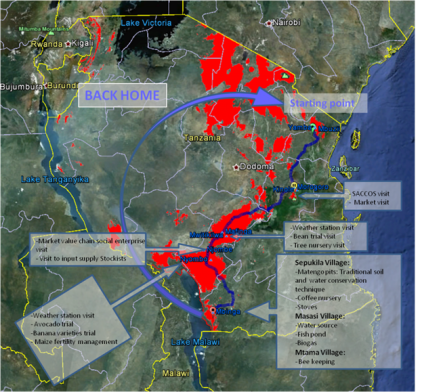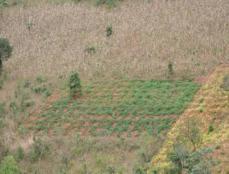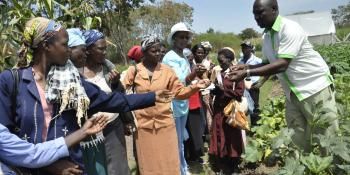One farmer's future is another farmer's present: Farms of the Future hits Tanzania

By Catherine Mungai, Maren Radeny and Caity Peterson
Fifty-five year old Rosalia Shemdoe feels empowered. She lives and works in Yamba village in the Lushoto district of northern Tanzania, but she just got back from what could be the longest journey she’s ever taken – one that ended in Mbinga, a district over 1,000 km away.
Rosalia, a single mother to six and grandmother to five, has been having a difficult time providing food and income for her family, a problem she attributes to unpredictable weather patterns and reduced productivity of her land. Her problem is urgent – how to provide food for her family in the days to come? – but she knows that thinking long-term is important too if her farm is to continue to support her and her family in the coming decades. Imagining such a future is no easy task, however. Talks and presentations, scientific data, and complicated maps and figures are all just about as much use as a crystal ball to a practical farmer with concrete questions. Rosalia needs to see what the scientists are talking about. Maybe then she can devise a way to prepare for the changes in store.
 A glimpse of what’s to come - no crystal ball necessary!
A glimpse of what’s to come - no crystal ball necessary!
As it turns out, Rosalia’s journey to Mbinga was a lot like a glimpse into her farm’s future, 20 or 30 years from now. Mbinga is a climate analogue location of Rosalia’s village, Yamba, meaning that the present-day climate of Mbinga looks a lot like how the future climate of Yamba could look.
As part of the CGIAR Research Program on Climate Change, Agriculture and Food Security (CCAFS) farms of the future project, Rosalia got the chance to participate in the first farmer-to-farmer exchange visit to Mbinga and several other analogue learning sites en route to see exactly what she might expect from the future, and, better yet, to learn how farmers there are already coping with their climate.
Using the Climate Analogues tool developed by CCAFS, an analogue map was developed for Yamba village. In May of 2012, Rosalia and 14 other farmers, along with 5 representatives from government and non-governmental organizations, went on a 10-day-long journey to 5 different learning sites across Tanzania, all close climate analogues of Yamba according to the CCAFS tool.

The principle: Go, see, and tell all about it
The key to a successful Farms of the Future exchange is that the information gets shared among many – not just the 15 farmers and policy makers that participated in the journey. Farmers from Yamba also learned how to use hand-held flip cameras to document the learning process. They later edited the videos themselves and shared them with other farmers who did not participate in the learning visit. They spoke with farmers in the learning sites about farming practices in their own village, making the visit a true exchange; the host farmers learned about adaptation strategies in addition to sharing their own.
Lushoto: strategies for the year 2030


The exchange group from Yamba was exposed to a wide range of ongoing community adaptation and risk management strategies. They saw a weather station and tree nurseries in Mwitikilwa, coffee plantations and stoves in Sepukila, a beekeeping enterprise in Mtama, and avocado, banana, and maize trials in Nyombo village. A highlight for many farmers was seeing the “matengo” pits in Mbinga district, a strategy used there to prevent heavy rain from washing away the soil on steep slopes. The pits act as sediment traps that hold green grasses, thus simultaneously preventing the soil from eroding and providing a source of nutrients for the subsequent season. Community members from Mbinga praise the matengo pits as a highly sustainable land management strategy that conserves both soil and water, while at the same time enriching the soil. The villagers from Yamba are now keen to try out the matengo pits for themselves.
Normally a primary school teacher in Yamba, this time Rosalia was the student. The Farms of the Future exchange gave her the chance to learn what other farmers are doing to survive in the climate that she could soon be facing. “In my village, farmers tend to purchase tree seedlings, but from the farmers here, I’ve discovered how to identify pine seeds from the forest and use them to prepare a tree nursery. I’m going to establish a tree nursery on my farm and generate more income by selling the tree seedlings to other farmers.” Rosalia’s participation in the Farms of the Future exchange has given her confidence she never had before. Now that she’s seen her future for herself, she can begin to take steps to prepare for the challenges ahead.
************
More about Farms of the Future
Farms of the Future, the product of a partnership between CCAFS, the Natural Resources Institute of the University of Greenwich, and national partners in Tanzania, aims to foster the knowledge exchange and learning opportunities about practices or technologies that might strengthen communities’ resilience and adaptive capacity to better respond to plausible novel future climates. The visits in Tanzania were the first in a series of pilots currently ongoing in East Africa, West Africa (Ghana) and South Asia (Nepal), with the goal of answering the following questions:
- Do farmers think that they have the required knowledge, attitudes and practices to adapt to a plausible future climatic condition?
- How do farmers envision their living environment in the year 2030?
- Just how adaptive are farmers, their communities and associated food systems?
- What are the major obstacles to effective, accelerated adaptation?
Read Neil Palmer’s blog on the Farms of the Future exchange in Beora, Nepal
Read more about the Climate Analogues tool launch and the CCAFS working paper No. 12, or try out the tool for yourself at the Climate Analogues website.
Catherine Mungai is a program specialist for the CCAFS regional program in East Africa. Maren Radeny is the CCAFS Regional Science Officer for East Africa. Caity Peterson is a visiting researcher based at the Center for International Tropical Agriculture (CIAT), working on Adaptation to Progressive Climate Change. To get more updates on our work on the analogues sites, like us on Facebook, and follow us on Twitter @Cgiarclimate.


